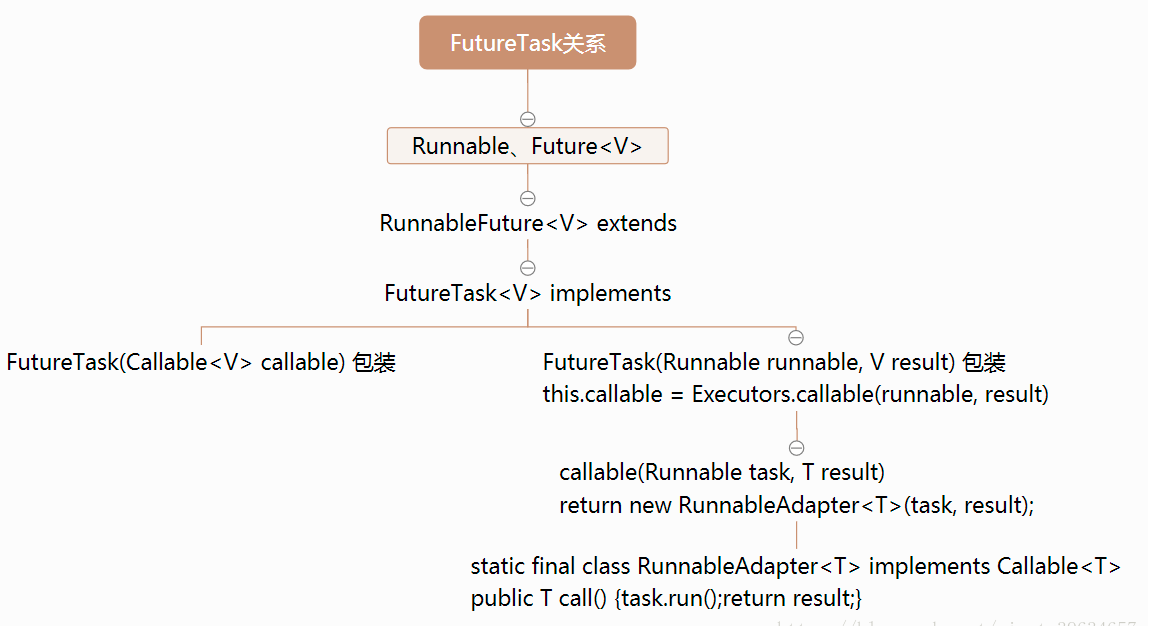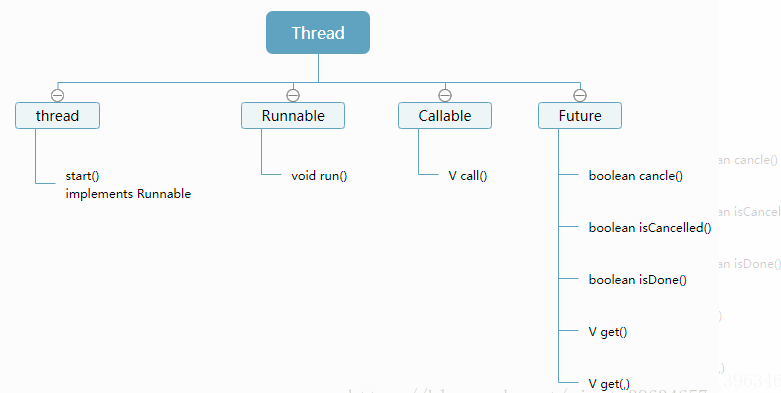Runnable
其中Runnable应该是我们最熟悉的接口,它只有一个run()函数,用于将耗时操作写在其中,该函数没有返回值。然后使用某个线程去执行该runnable即可实现多线程,Thread类在调用start()函数后就是执行的是Runnable的run()函数。Runnable的声明如下 :
public interface Runnable {
/*
* @see java.lang.Thread#run()
*/
public abstract void run();
}
Callable
Callable与Runnable的功能大致相似,Callable中有一个call()函数,但是call()函数有返回值,而Runnable的run()函数不能将结果返回给客户程序。Callable的声明如下 :
public interface Callable<V> {
/**
* Computes a result, or throws an exception if unable to do so.
*
* @return computed result
* @throws Exception if unable to compute a result
*/
V call() throws Exception;
}
Future
Executor就是Runnable和Callable的调度容器,Future就是对于具体的Runnable或者Callable任务的执行结果进行
取消、查询是否完成、获取结果、设置结果操作。get方法会阻塞,直到任务返回结果(Future简介)。Future声明如下 :
public interface Future<V> {
/**
* Attempts to cancel execution of this task. This attempt will
* fail if the task has already completed, has already been cancelled,
* or could not be cancelled for some other reason. If successful,
* and this task has not started when <tt>cancel</tt> is called,
* this task should never run. If the task has already started,
* then the <tt>mayInterruptIfRunning</tt> parameter determines
* whether the thread executing this task should be interrupted in
* an attempt to stop the task.
*/
boolean cancel(boolean mayInterruptIfRunning);
/**
* Returns <tt>true</tt> if this task was cancelled before it completed
* normally.
*/
boolean isCancelled();
/**
* Returns <tt>true</tt> if this task completed.
*
*/
boolean isDone();
/**
* Waits if necessary for the computation to complete, and then
* retrieves its result.
*
* @return the computed result
*/
V get() throws InterruptedException, ExecutionException;
/**
* Waits if necessary for at most the given time for the computation
* to complete, and then retrieves its result, if available.
*
* @param timeout the maximum time to wait
* @param unit the time unit of the timeout argument
* @return the computed result
*/
V get(long timeout, TimeUnit unit)
throws InterruptedException, ExecutionException, TimeoutException;
}
FutureTask
FutureTask是一个RunnableFuture<V>
public class FutureTask<V> implements RunnableFuture<V>
RunnableFuture实现了Runnbale又实现了Futrue<V>这两个接口
public interface RunnableFuture<V> extends Runnable, Future<V> {
/**
* Sets this Future to the result of its computation
* unless it has been cancelled.
*/
void run();
}
另外FutureTaslk还可以包装Runnable和Callable<V>, 由构造函数注入依赖。
public FutureTask(Callable<V> callable) {
if (callable == null)
throw new NullPointerException();
this.callable = callable;
this.state = NEW; // ensure visibility of callable
}
public FutureTask(Runnable runnable, V result) {
this.callable = Executors.callable(runnable, result);
this.state = NEW; // ensure visibility of callable
}
上面代码块可以看出:Runnable注入会被Executors.callable()函数转换为Callable类型,即FutureTask最终都是执行Callable类型的任务。该适配函数的实现如下 :
public static <T> Callable<T> callable(Runnable task, T result) {
if (task == null)
throw new NullPointerException();
return new RunnableAdapter<T>(task, result);
}
RunnableAdapter适配器
/**
* A callable that runs given task and returns given result
*/
static final class RunnableAdapter<T> implements Callable<T> {
final Runnable task;
final T result;
RunnableAdapter(Runnable task, T result) {
this.task = task;
this.result = result;
}
public T call() {
task.run();
return result;
}
}
FutureTask实现Runnable,所以能通过Thread包装执行,
FutureTask实现Runnable,所以能通过提交给ExcecuteService来执行
注:ExecuteService:创建线程池实例对象,其中有submit(Runnable)、submit(Callable)方法
还可以直接通过get()函数获取执行结果,该函数会阻塞,直到结果返回。
因此FutureTask是Future也是Runnable,又是包装了的Callable( 如果是Runnable最终也会被转换为Callable )。
Callable 和 Future接口的区别
1.Callable规定的方法是call(),而Runnable规定的方法是run().
2.Callable的任务执行后可返回值,而Runnable的任务是不能返回值的。
3.call()方法可抛出异常,而run()方法是不能抛出异常的。
4.运行Callable任务可拿到一个Future对象, Future表示异步计算的结果。
5.它提供了检查计算是否完成的方法,以等待计算的完成,并检索计算的结果。
6.通过Future对象可了解任务执行情况,可取消任务的执行,还可获取任务执行的结果。
7.Callable是类似于Runnable的接口,实现Callable接口的类和实现Runnable的类都是可被其它线程执行的任务。
示例:
package com.xzf.callable;
import java.util.concurrent.Callable;
import java.util.concurrent.ExecutorService;
import java.util.concurrent.Executors;
import java.util.concurrent.Future;
import java.util.concurrent.FutureTask;
public class RunnableFutureTask {
static ExecutorService executorService = Executors.newSingleThreadExecutor(); //创建一个单线程执行器
public static void main(String[] args) {
runnableDemo();
futureDemo();
}
/**
* new Thread(Runnable arg0).start(); 用Thread()方法开启一个新线程
* runnable, 无返回值
*/
static void runnableDemo() {
new Thread(new Runnable() {
public void run() {
System.out.println("runnable demo:" + fibc(20)); //有值
}
}).start();
}
/**
* Runnable实现的是void run()方法,无返回值
* Callable实现的是 V call()方法,并且可以返回执行结果
* Runnable可以提交给Thread,在包装下直接启动一个线程来执行
* Callable一般都是提交给ExecuteService来执行
*/
static void futureDemo() {
try {
Future<?> result1 = executorService.submit(new Runnable() {
public void run() {
fibc(20);
}
});
System.out.println("future result from runnable:"+result1.get()); //run()无返回值所以为空,result1.get()方法会阻塞
Future<Integer> result2 = executorService.submit(new Callable<Integer>() {
public Integer call() throws Exception {
return fibc(20);
}
});
System.out.println("future result from callable:"+result2.get()); //call()有返回值,result2.get()方法会阻塞
FutureTask<Integer> result3 = new FutureTask<Integer>(new Callable<Integer>() {
public Integer call() throws Exception {
return fibc(20);
}
});
executorService.submit(result3);
System.out.println("future result from FutureTask:" + result3.get()); //call()有返回值,result3.get()方法会阻塞
/*因为FutureTask实现了Runnable,因此它既可以通过Thread包装来直接执行,也可以提交给ExecuteService来执行*/
FutureTask<Integer> result4 = new FutureTask<Integer>(new Runnable() {
public void run() {
fibc(20);
}
},fibc(20));
executorService.submit(result4);
System.out.println("future result from executeService FutureTask :" + result4.get()); //call()有返回值,result3.get()方法会阻塞
//这里解释一下什么FutureTask实现了Runnable结果不为null,这就用到FutureTask对Runnable的包装,所以Runnable注入会被Executors.callable()函数转换成Callable类型
FutureTask<Integer> result5 = new FutureTask<Integer>(new Runnable() {
public void run() {
fibc(20);
}
},fibc(20));
new Thread(result5).start();
System.out.println("future result from Thread FutureTask :" + result5.get()); //call()有返回值,result5.get()方法会阻塞
} catch (Exception e) {
e.printStackTrace();
}finally {
executorService.shutdown();
}
}
static int fibc(int num) {
if (num==0) {
return 0;
}
if (num==1) {
return 1;
}
return fibc(num-1) + fibc(num-2);
}
}

